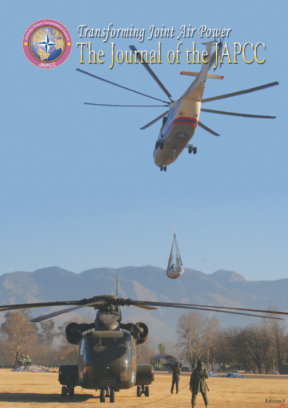Editorial
“My logisticians are a humourless lot … they know if my campaign fails, they are the first ones I will slay.”
Alexander the Great
While NATO’s approach to logistics may not be as direct as Alexander’s, achieving effective and efficient joint deployment and sustainment is one of Allied Command Transformation’s 3 transformational goals. To airmen logistics might not be as ‘sexy’ as achieving coherent effects or as apparently progressive as achieving decision superiority, the other 2 transformation goals, but air power’s contribution to, and reliance on, joint deployment and sustainment are of critical importance. The air power perspective of achieving joint deployment and sustainment is the theme of this, the fourth edition, of the Journal of the Joint Air Power Competence Centre.
The improvement of NATO’s strategic airlift was a Prague Capabilities Commitment. Lt Col Mike Carter considers NATO’s requirement for strategic airlift and, from the other side of the world, Sqn Ldr Timothy Anderson provides a RAAF perspective. Brig Gen Cazeméa provides a recent practical experience of NATO airlift from the Pakistan Earthquake relief effort.
Winston Churchill said that ‘Strange as it may seem, the Air Force, except in the air, is the least mobile of all the Services. A squadron can reach its destination in a few hours, but its establishment, depots, fuel, spare parts, and workshops take many weeks, and even months, to develop’. Maj Patrick Piana introduces the fundamental issues to be considered in the transformation of Allied Air Logistics. One option for the efficient use of resources is for NATO to exploit contractor support, as examined by Professor Tore Listou of the Norwegian Defence College.
A critical capability is the ability to activate airfields. Lt Col Spaulding contrasts US, NATO, and EAG work in this area, and Gp Capt David Blore explains the EAG’s concept. Equally important is the protection of the force. Brig Gen Mehmet Çetin, Director of the Joint Allied Lessons Learned Centre, identifies the force protection lessons learned in NATO operations in Afghanistan. Gp Capt John Alexander examines a proposed NATO doctrinal approach to force protection risk management and Col René Arns explains the operational risk management model adopted by the Netherlands.
I am grateful to the new German Chief of Air Staff for his views on the future of the German Air Force. Finally our ‘out of the box’ feature looks ahead to the next edition of the Journal on the multidimensional theme of C4ISTAR.
I hope you enjoy reading this edition of the JAPCC Journal.
Ian Dugmore
Air Commodore, UK AF
Assistant Director Transformation, JAPCC









